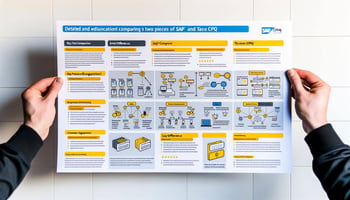Tacton CPQ is available in two editions – Tacton CPQ Enterprise and Tacton CPQ Professional. The...
Shootout: Tacton CPQ vs SAP CPQ
I recently came across an article (link) discussing the implementation of SAP CPQ and the challenges that come with it.
The article highlights the importance of the hybrid agile approach and the impact it had on the success of the project. This is not exactly how we work at cpq.se, but this might be a necessity working with at system like SAP CPQ.
In this article, we will first dive deeper into the four key things that were learned during the implementation process.
The 4 Things We Learned from the article
-
Preparation is key: The company carried out an initial phase before the actual implementation of the CPQ system, which helped to prepare the organization for the upcoming changes and involve all the relevant knowledge holders. This preparation was considered a key success factor and should be taken into account when implementing projects in companies with similar structures and starting situations.
-
Standardization leads to reduced complexity: The company was able to reduce complexity through standardization, which led to distinct reductions in the time it took to prepare an offer. The number of Standard Delivery Elements was reduced from over 600 to approximately 30 predefined, scalable services that could be configured using the underlying rule sets in the CPQ system.
-
Collaboration is essential: The iterative design of the hybrid agile process model created transparency and trust among experts from multiple business domains. A clear strategic positioning of the project from the beginning was essential for the success of the CPQ implementation.
-
Continuous adaptation and maintenance of the knowledge base is necessary: The portfolio should be completely available in a CPQ system, which also requires a continuous process of adapting and maintaining the CPQ knowledge base.
The Difference between SAP CPQ and Tacton CPQ
While both SAP CPQ and Tacton CPQ are software solutions that aid in the configuration of products and services, there are some differences between the two.
SAP CPQ provides a platform for configuring complex products and services. It is designed to work with other SAP products and provides a hybrid agile approach to implementation. On the other hand, Tacton CPQ is a cloud-based solution ranked as a leader of configure products and services for the manufacturing industry. It is designed to work with a wide range of enterprise systems and provides a visual and intuitive interface.
The implementation process and functionality of Tacton CPQ differs from SAP CPQ in several ways. While both solutions focus on streamlining the sales process and providing accurate product configurations, they have different approaches to achieving this goal.
Tacton CPQ uses a constraint-based configuration approach, which allows businesses to create complex, customized products through the use of business rules and algorithms. This means that Tacton CPQ can handle very complex configurations and automatically optimize configurations for the best outcome, all while providing a user-friendly interface. In addition, Tacton CPQ integrates with other enterprise systems, such as CRM and ERP, for a seamless sales process.
On the other hand, SAP CPQ uses a more template-driven approach, which relies on pre-defined rules and templates to configure products. While this can limit the complexity of configurations, it also simplifies the implementation process and makes it easier to manage the system. SAP CPQ also integrates well with other SAP solutions, such as SAP CRM and SAP ERP, which can be beneficial for businesses already using these systems.
Powerful tools for streamlining
SAP CPQ and Tacton CPQ are both powerful tools for streamlining the quoting process and improving sales efficiency. However, there are some significant differences between the two solutions.
-
Integration: SAP CPQ is part of the larger SAP suite of enterprise resource planning (ERP) software, while Tacton CPQ is a standalone product. This means that SAP CPQ is designed to integrate seamlessly with other SAP modules, while Tacton CPQ can be used with a variety of different systems.
-
Focus: Tacton CPQ is designed specifically for complex products and configurations, while SAP CPQ is geared more towards simple and mid-market configurations. Tacton's strengths lie in its ability to handle intricate engineering and product data, while SAP CPQ offers a more straightforward user interface for simpler product lines.
-
Customization: Tacton CPQ offers a higher degree of customization, with the ability to create complex rule sets and logic. This makes it well-suited for industries such as manufacturing, where products can have many configurable options. SAP CPQ, on the other hand, offers more out-of-the-box functionality, which can make it easier to set up and use.
-
User experience: SAP CPQ offers a user-friendly interface that is easy to navigate, making it a good choice for sales teams who need to generate quotes quickly. Tacton CPQ can be more complex, but offers greater flexibility and control over the quoting process.
-
"AI capabilities": Tacton CPQ support extensive guidance for the users through the configuration process and make recommendations based on customer data. SAP CPQ also offers "AI capabilities", but they are more limited in scope and application.
In summary, both SAP CPQ and Tacton CPQ offer powerful solutions for streamlining the quoting process and improving sales efficiency. The choice between the two will depend on the specific needs of the business and the complexity of the products being quoted. SAP CPQ is a good fit for simpler products and those in the mid-market, while Tacton CPQ offers more advanced customization and handling of complex configurations.
Ultimately, the choice between Tacton CPQ and SAP CPQ will depend on the specific needs of the business. If the business requires complex product configurations and has the resources to manage a rules-based approach, Tacton CPQ may be the better option. If the business is looking for a more streamlined implementation process and already uses other SAP solutions, SAP CPQ may be the better choice.




